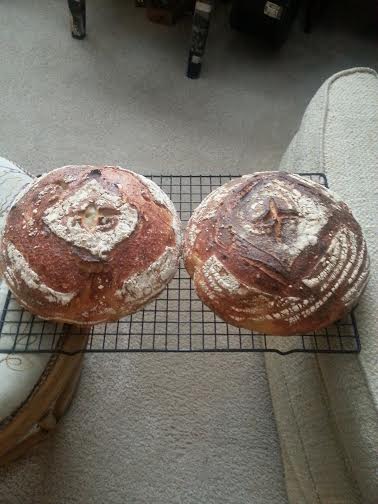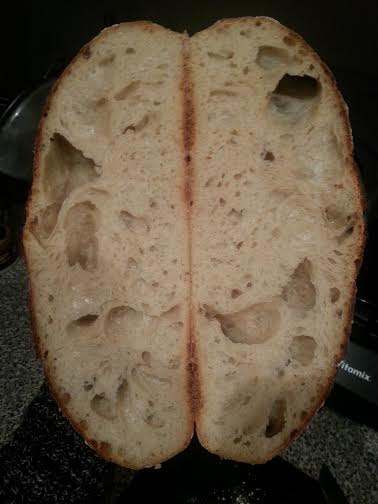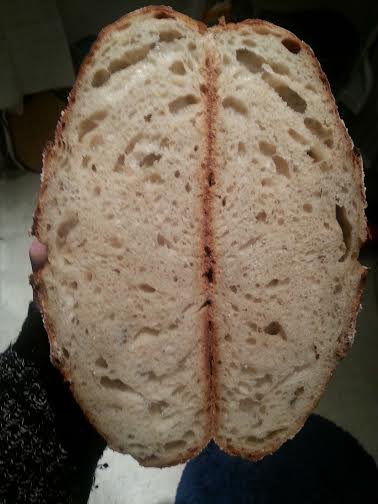For my first real post, I'd like to share the results of this little experiment: I wanted to test the merits of the long cold fermentation vs. the long cold proof.
Both loaves had the same ultimate flour content and hydration (80%). As for the long ferment, I know that 300 grams of 100% levain seems high for a loaf with 500 grams of total flour, but I've had good results with that percentage of levain in my short baking tenure. I halfed the amount of levain for the long proof, because I have been disappointed with overproofing with that technique in the past. Also, I know that my dollop of cream cheese is unorthodox, but it's my little "secret" ingredient in sourdough...I just like to keep it interesting!
Ingredients for Long Cold Ferment:
300g 100% hydration levain
300g AP flour
50g WW flour
250g water
11g salt
Dollop cream cheese
Ingredients for Long Cold Proof:
150g 100% hydration levain
375g AP flour
50g WW flour
325g water
11g salt
Dollop cream cheese
For both: I mixed flour and water and autolysed for 2 hours, then added levain and salt. Did 4 stretch-and-folds at 30 minute intervals, for 2 hours. I then let both rest for 2 hours at room temperature. I placed the long-ferment dough in the fridge to continue its journey, and I shaped the long-proof dough into a boule and placed it in a banneton. I forgot the pre-shape! Anyhow, it went into the fridge.
Both doughs were refrigerated for around 16 hours.
I removed the long-proof dough and let it rest at room temperature for 1 hr before baking T 450 for 30 minutes with steam, 20 minutes without.
I removed the long-ferment dough, shaped it, and let it proof for 1 hr before baking at 450 for 30 minutes with steam, 20 minutes without.
Results:
Long Ferment Left, Long Proof Right

Ovenspring almost identical!

But, once sliced...the long-proofed loaf had a much larger and more irregular crumb.
Long Proof:

Long Ferment:

Both were milder in flavor than I expected. The longer cold-proofed loaf was definitely maltier, had a thinner crust, and was possibly more complex than the longer cold-fermented loaf...but the flavor difference was really minimal. I still find long bulk fermentation more flexible and less nerve-wracking than long proofing (is it over-proofing? Is it over-proofing?!). I almost wanted a more drastically different result, so I could make a hard and fast decision! As it stands...I'm just gonna have to continue experimenting...
- a_warming_trend's Blog
- Log in or register to post comments
It's a really interesting experiment, but based on the numbers it isn't really a comparison of long proof vs. long fermentation. That is - there are enough other variables to skew the results. By my figuring, your long ferment dough is 80% hydration, whereas your long proof dough is slightly under 70% hydration; that alone would make a very big difference in the resulting bread and would go some way toward accounting for differences in crumb density, no? Add to that that in the long ferment dough 30% of your flour is pre-fermented, whereas in the long proof dough only 13% is pre-fermented. Again - big difference!
I don't mean to rain on the parade of your research - on the contrary, this is an inquiry very much after my own heart - but you've got three major factors going on instead of one. Seems to me that the only real way to determine the effects of changing any one factor is to test it on a level playing field - that is, using a dough composition that is identical in all other respects.
That said... your bread looks great, and now you've got me *really* curious about the effects of that dollop of cream cheese! ;-)
Hi, Balmagowry. Thanks so much for your excellent insights! To address your points:
1) Hm...I do think that the hydration levels are ultimately both 80%:
A) Long ferment: 150 from preferment, 250 in final dough = 400
B) Long proof: 75 from preferment, 325 in final dough = 400
2) You are absolutely right that the levain percentage difference between the two doughs disqualifies it as a true controlled experiment. I struggled with that, because A) I KNEW that I couldn't do 30% in the long proof, because I've had such doughs overproof twice before, and B) I've really enjoyed recent results with 30% in long ferment, and C) I knew that I'd promised half-loaves to two people, and I wasn't willing to have a disaster this time. Ha!
I think that next time I try it, I will do 13% for both. I need to increase my confidence with lower preferment percentages in general.
I hope to try this again sometime in January. Gonna add a very long autolyse next time. For both doughs, though, I promise!
The crumb of the long fermented loaf improved as I sliced further in. It actually makes intuitive sense that the long-proof would have larger air holes...shaping tightly enough for good ovenspring after a long ferment is ALWAYS going to degas the loaf slightly, right? The long proof has had so much time to just sit there and get all comfortable with its holiness. Although TX Farmer's 36 hour formula seems to produce the most open crumb I've ever seen, and that's with a long ferment. So. So!
Pretty happy with with the second-day flavor of both.
Duh. That'll larn me to add things in my head and on the fly. Of course you are right about the hydration. For some reason I forgot to divide the 150 in half for levain flour in the second formula, though I remembered it when figuring out the water. So that gave me 575g flour instead of 500g. My bad!
OK, so equal hydration, but still very different pre-ferment percentages. Aside from that, how much difference does long-proof/long-ferment really make? I wonder. I suspect that in a really controlled situation you'd be looking at some pretty subtle differences, probably depending greatly on how much shaping you do. I just made the Pierre Nury Light Rye loaf (note to self: must post about this), which basically is not shaped at all, just divided, flattened, and slapped into the oven as soon as it's warmed up from its long retard. Except for needing to de-gas a bit, I can't see that it would matter very much if something like that were shaped before the retard. OTOH, with a more structured hearth loaf, one where you explicitly build the gluten sheath by folding the dough during shaping to increase surface tension - there I imagine you'd see more of a difference, because the gluten structure has a lot more time to relax before baking.
There should also be some difference in crust appearance - this is why I prefer to shape bagels after an overnight retard instead of before, because I usually like a very smooth shiny crust better than the blistery one you get if you shape them first.
I'm sorry that I don't quite understand the point. What is the difference between two fermentation methods, long cold fermentation vs long cold proof? Both are retarded in the fridge for the same amount of time. Apart from the amount of levain, is the difference to shape or not to shape before going into the fridge?
wildeny, yes, it's a question of whether the retarding happens during bulk fermentation (1st rise) or proofing (second rise). I agree with balmagowry that any difference will likely be much more pronounced in loaves involving lots of shaping.
As to the usefulness of the experiment: I wouldn't have imagined there would be such conflicting ideas here, but a search of older TFL threads revealed that even very experienced bakers (both home and professional) have a wide range of preferences here. Even down to the question of whether to let a cold-proofed loaf "warm up" at all before heading to the oven. I'd imagine if everyone on the forum weighed in on this very post, we'd get a spectrum of perspectives!
I'm sure I'll explore it at least a few more times in the new year. Maybe it'll be interesting, maybe not...but hopefully my experiments will at the very least yield a couple of tasty loaves!
When i make identical breads with one long cold proof and one long cold bulk ferment, the long cold proof always has much larger and more irregular holes too. Not handling it a couple of hours right before baking really makes a big difference. It's all in the handling if you ask me.